Ensuring Resiliency and Scalability in the Digital Age: The Role of Azure Load Testing in Application Management
Introduction
In today’s digital environment, ensuring that your applications can manage high traffic efficiently is crucial for maintaining a competitive edge. Azure Load Testing provides a robust solution for evaluating application performance and scalability under various load conditions, helping businesses optimize their resources and deliver superior user experiences. As organizations expand and evolve, they must leverage tools that not only enhance technical capabilities but also align with their strategic goals. This blog will guide you through utilizing Azure Load Testing to ensure your application meets performance expectations, ultimately supporting your business growth and customer satisfaction.
Problem Statement
As user bases expand and applications become more complex, it is vital to assess how these applications perform under different levels of stress. Traditional load testing methods often faced significant challenges, such as:
- Complex Setup and Maintenance: Setting up load testing environments required considerable time and resources. Maintaining these environments took a lot of work, leading to delays in testing cycles.
- Scalability Issues: Traditional load testing tools struggled to scale, making it difficult to simulate realistic traffic patterns for high-volume applications.
- Inconsistent Results: Lack of standardized testing environments often resulted in inconsistent and unreliable test results, making it hard to pinpoint performance bottlenecks accurately.
- Limited Real-time Monitoring and Analysis: Many traditional tools did not offer real-time monitoring and analytics, delaying the identification and resolution of performance issues.
Azure Load Test
Azure Load Testing is a fully managed service that enables users to execute load tests using JMeter scripts without the need to manage the underlying infrastructure. This service simplifies the process of setting up, configuring, and running load tests by utilizing JMeter scripts, while also taking advantage of Azure’s scalability, monitoring tools, and integration features. It allows you to use your existing JMeter scripts within Azure Load Testing, benefiting from the cloud’s scalable resources and the broader Azure ecosystem for effective performance testing.
Azure Load Testing uses Apache JMeter in the background and offers additional features beyond those provided by JMeter alone.
Azure Load Testing |
Apache JMeter |
| In terms of scalability, Azure Load Testing offers seamless cloud-native scalability. | GUI scalability is limited; handling large-scale tests can be challenging without switching to non-GUI mode |
| Provides Efficient cloud resource management | Resource-intensive, especially with complex scenarios and large thread counts |
| Provides Built-in real-time monitoring and analytics | Does not include built-in real-time monitoring and may need integration with external tools. |
| Focuses on server-side performance | Limited support for native browser interactions and complex JavaScript behaviours |
| Provides Efficient integration with Azure DevOps and CI/CD pipelines | Resource-intensive in CI environments, especially for frequent large-scale tests |
| Integrated with Azure’s security standards | Offers basic security testing but lacks more advanced security testing capabilities. |
Solution Approach
To resolve these problems, we can use Azure Load Testing. Azure Load Testing generates high-scale load to simulate traffic for your applications, regardless of their hosting environment. Developers, testers, and QA engineers can use it to optimize application performance, scalability, and capacity.
You can create a load test using existing test scripts based on Apache JMeter, a popular open-source load and performance tool. For Azure-based applications, detailed resource metrics help identify performance bottlenecks. Continuous integration and continuous deployment (CI/CD) workflows allow for automated regression testing.

Azure Load Testing
Load Testing Key Concepts
JMeter: JMeter is a versatile open-source tool designed for load testing. It evaluates the functional behavior of software applications and gauges their performance under varying conditions. The tool’s flexibility and customization options enable users to tailor their load tests to meet specific requirements and scenarios. JMeter test scripts, defining various load profiles and parameters, can be uploaded to the Azure Load Testing service and run within the Azure environment.
Read More: Azure Backup Center: A Complete Guide to Modern Data Protection
Test Engine Instance: This is a computing resource managed by Microsoft, located in the same region as the Azure Load Testing resource. It runs Apache JMeter test scripts. The test case configuration specifies the number of engine instances, influencing the total number of virtual users. During the execution of the test script, logs generated by the Apache JMeter worker are collected and aggregated by the Azure Load Testing service, providing comprehensive analysis at the test’s conclusion.
Test: A test defines the load test setup for your application and can be added to an existing Azure Load Testing resource. It also includes a test plan that details the steps to invoke the application endpoint. You can define the test plan in one of three ways:
- Upload a JMeter test script.
- Upload a Locust test script.
- Specify the list of URL endpoints to test.
The load test execution involves configuring the following test settings:
- Azure Load Testing supports executing tests based on Apache JMeter or Locust. For example, your test plan might consist of multiple application requests, you can create a URL-based load test that contains multiple requests. Up to five HTTP requests can be included in a load test, utilizing any HTTP methods like GET, POST, and others.

URL-Based test
- Parameters for the load test include environment variables, secrets, and certificates.
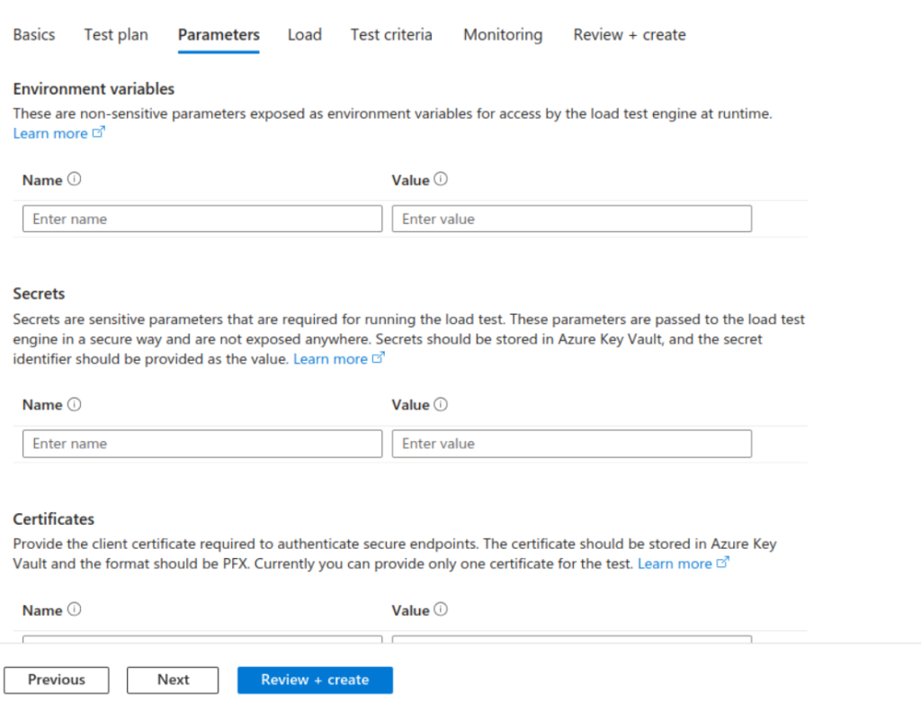
Parameters
- Configure the load to distribute it across multiple test engine instances.
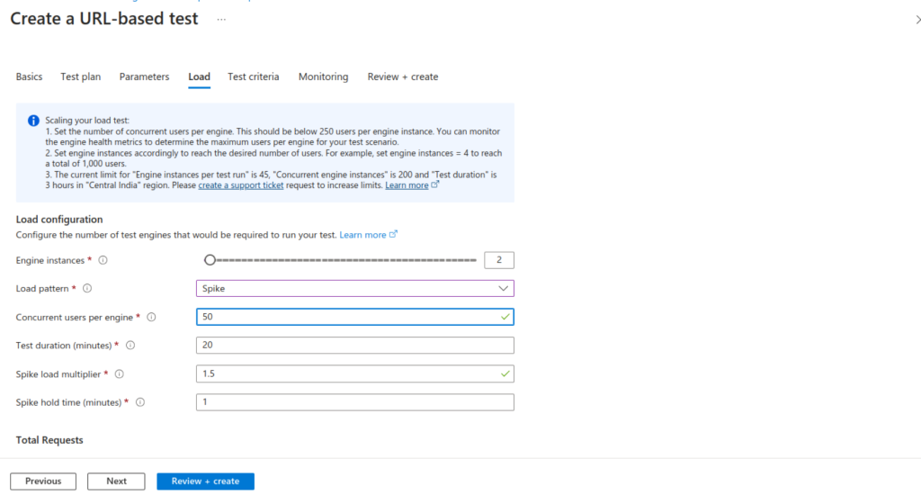
Load-Configuration
- Enable the test traffic to reach your public or private endpoint. For private endpoints select your virtual network and subnet. If you have multiple subnets in your virtual network, make sure to select the subnet that will host the injected test engine VMs.

Network-Setting
- Criteria for assessing whether the test should pass or fail.
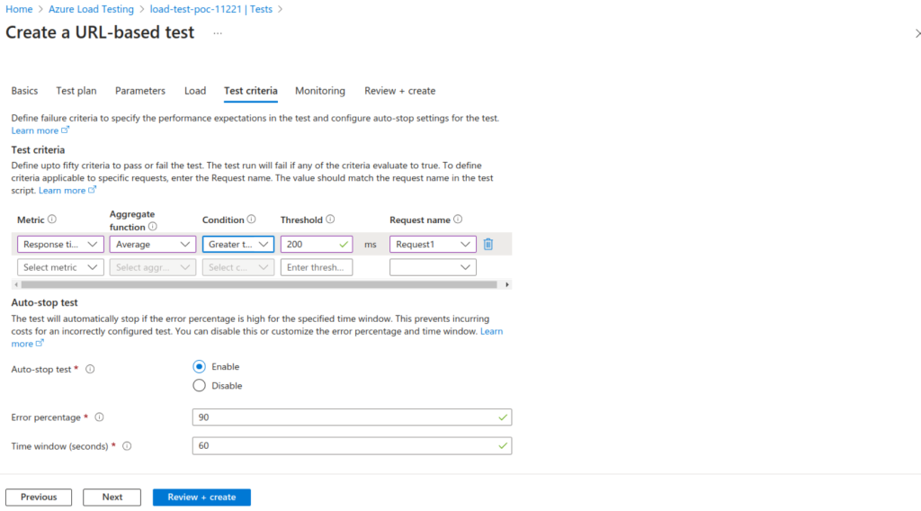
Test Criteria
- Monitoring settings to specify which Azure app components and resource metrics to track during the test run.

Monitoring
Performance Evaluation
The Azure Load Testing service measures various indicators such as response times, throughput, and resource utilization to ensure the application meets performance benchmarks.
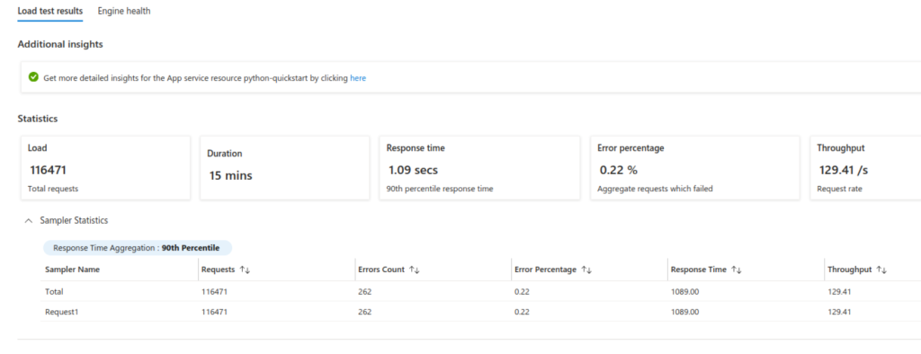
load test result
Metrics can be categorized into:
- Client-side Metrics: These results, provided by the test engine, encompass all test aspects, including the number of virtual users, requests per second, and the count of successful or failed requests.

Client-Side metrics
- Server-side Metrics: Integrating with Azure Monitor, these logs capture detailed insights based on the running service, including resource consumption, database queries, and HTTP requests.
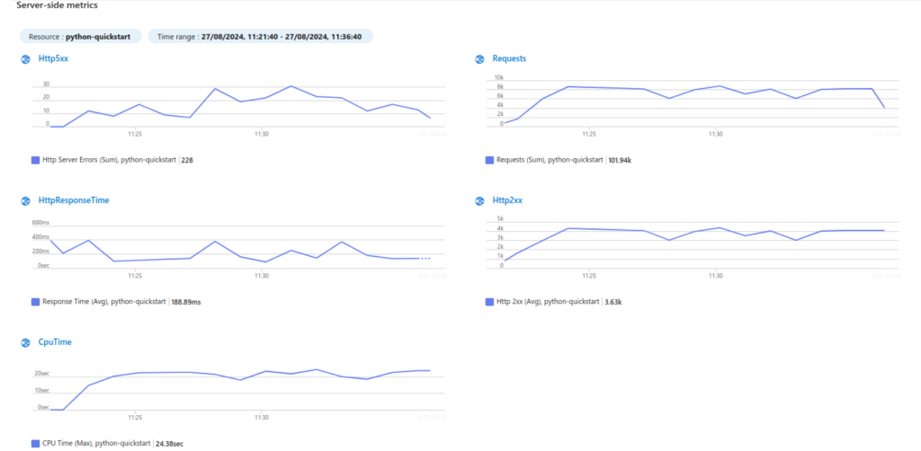
Server-side Metrics
Process Flow
- Users: Initiate load tests either directly, via Azure DevOps, or from GitHub.
- Quick Test/JMeter Script: Users can quickly run predefined tests or use JMeter scripts for customized load tests.
- Test Engines: Execute the load tests by simulating multiple users and generating traffic.
- Metrics and Dashboard: Gather and present performance data.
- Azure Monitor: Provides additional monitoring and diagnostics capabilities to analyse the test results.
- Application and Dependencies: The target application and its dependencies are subjected to the load, and their performance is measured to ensure they can handle the expected traffic.
Cost
- Load Testing Resource:
$10 per month: This includes 50 Virtual User Hours (VUH) per month. - Virtual User Hour (VUH) additional usage:
For 0 to 9,950 additional Virtual User Hours: $0.15 per additional VUH.
For 9,950+ additional Virtual User Hours: $0.075 per additional VUH.

Cost
A Virtual User Hour is calculated as (the number of virtual users simulated * the duration of the simulation in minutes) / 60 minutes per hour. The number of active virtual users is counted every 10 seconds, and you are charged for the equivalent number of fractional Virtual User Hours you use. For instance, simulating 1,000 virtual users for 30 minutes would result in a charge for 500 virtual user hours.
Read More: Guide To Host Drupal Application on Azure Container Instance (ACI)
Conclusion
Azure Load Testing is a powerful tool for validating your application’s performance under various load conditions, directly impacting your business’s bottom line. By enabling you to replicate real-world traffic and detect performance issues, Azure Load Testing helps optimize your application to manage high loads efficiently. Regular load testing not only maintains a high-quality user experience but also prepares your application for future growth and scalability. In an era where digital performance can determine business success, investing in effective load testing solutions like Azure Load Testing is essential for organizations aiming to enhance their operational resilience and sustain a competitive advantage.



